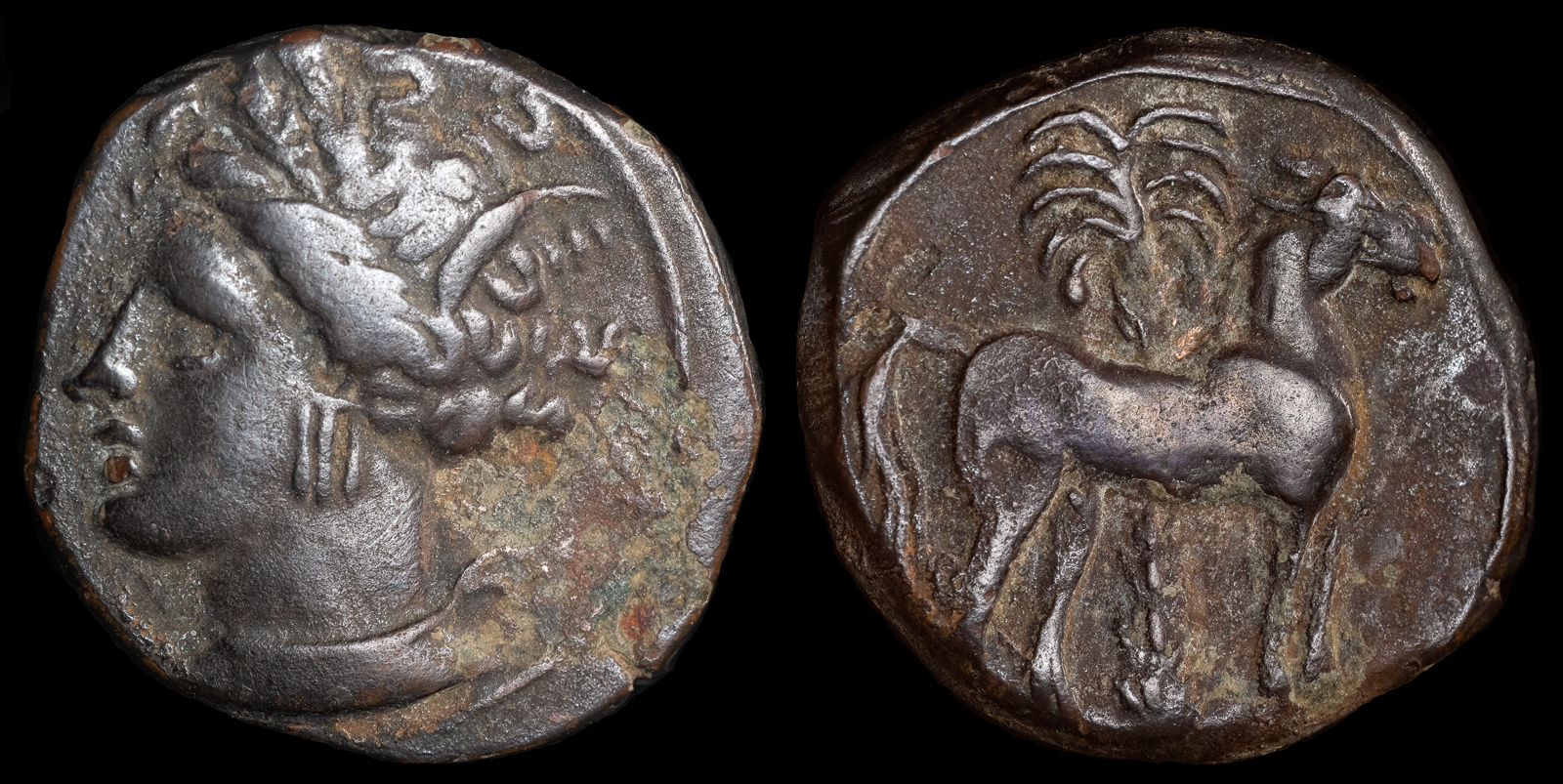
Carthage
Circa 400-350 BCE
AE 15mm, 2,4g
Head of Tanit to left, wearing wreath of grain ears.
Rev. Horse standing right; palm tree in background.
MAA 18. SNG Copenhagen 109
Admittedly, Carthage played mostly an indirect role during the time of Alexander the Great. During the Siege of Tyre, many of the inhabitants were evacuated to Carthage, which like Tyre was a Phoenician city. Unlike the Phoenician cities of the Levant, however, it played a more active role in world affairs, contending in Sicily and eventually against the Romans.
I’ve often wondered if some of my ancestors lived in Carthage. In a 23AndMe study, I found that many of my ancestors had African and Levantine blood. Since my family are Sephards who once lived in Spain, I’ve often wondered how they got there. My suspicion is some likely traded with Phoenicians and may have even been Phoenicians. Since Carthage had a large Jewish population, perhaps they may have lived there.
The other connection with Alexander the Great was the premise that Alexander’s next intention was to build a huge fleet and conquer the Mediterranean. Clearly Carthage would have been the most affected by this and was likely Alexander’s chief objective, if this truly was his plan.
Traditional founding date of Carthage by Phoenician settlers from Tyre, led by Queen Dido (according to legend).
Carthage wins a significant victory against the Greek city of Phokaia near Corsica, marking the beginning of its rivalry with Greek settlements in the western Mediterranean.
Carthage signs its first known treaty with Rome, delineating spheres of influence and trade routes.
Hannibal Mago (a general and political leader) expands Carthaginian territories in Sicily, initiating a new wave of Carthaginian influence on the island.
Akragas sacked by Carthage.
The general Himilco of Carthage concludes a treaty with Kephaloidion.
Syracuse signs a treaty with Carthage that increases its possessions.
The population of Hipponion returns to their city with the help of Carthage.
Carthage renews its treaty with Rome, reinforcing agreements on trade and territorial boundaries. Mastia is mentioned.
Outbreak of the Agathokles War: The tyrant Agathokles of Syracuse invades North Africa, threatening Carthage but is ultimately repelled.
Agathokles‘ conflict with Carthage escalates. Agathokles faces a major invasion by the Carthaginian general Hamilcar, who besieges Syracuse. In a daring move, Agathokles decides to strike back by invading North Africa.
Agathokles launches his expedition to North Africa, landing near Carthage. His unexpected attack catches the Carthaginians off guard, and he achieves several victories on African soil. Agathokles declares himself king of Sicily during this campaign, marking a significant shift in his ambitions.
Agathokles persuades Ophellas of Kyrene to join him as an ally against Carthage. Agathokles at first receives him warmly, then attacks his camp unexpectedly, kills Ophellas, and claims his troops.
Pyrrhos captures Eryx, the most powerful stronghold of Carthage on Siciliy.
The navy of Pyrrhos is defeated by Carthage at the Battle of the Strait of Messina.
First Punic War begins between Rome and Carthage over control of Sicily.
261 BCE
Rome lays siege to Akragas. Carthage attempts to relieve it, but the city is taken and its inhabitants sold into slavery.
Roman troops near Thermai Himeraiai are attacked by Carthage under Hamilcar and defeated.
Carthage recaptures Akragas.
Iaitas expel their garrison from Carthage and hand the city over to the Romans.
Peace settlement ends the First Punic War between Carthage and Rome. Akragas is given to Rome.
Hamilcar Barca begins the Carthaginian expansion in Iberia (Spain), establishing a base for Carthage’s later campaigns.
Hasdrubal of Carthage renames Mastia to Qart Hadasht, or “New City”.
Carthaginian general Hannibal attacks Saguntum in Iberia, leading to the Second Punic War with Rome.
Battle of Cannae: Hannibal of Carthage defeats a large Roman army, inflicting one of Rome’s worst defeats.
Akragas shifts its loyalty to Carthage in the Second Punic War.
Thourion defects to Carthage after the Battle of Cannae.
Hannibal of Carthage removes the citizens of Atella to Thourion.
Aesernia remains loyal to Rome during the Second Punic War against Carthage.
Hannibal of Carthage removes 3500 wealthy citizens of Thourion to Krotona, then lets his troops plunder it.
Battle of Zama: Roman general Scipio Africanus defeats Hannibal in North Africa, ending the Second Punic War. Carthage is forced to surrender and pay heavy reparations to Rome.
Third Punic War begins after Roman accusations of Carthaginian breaches of treaty terms.
Destruction of Carthage: Roman forces led by Scipio Aemilianus capture and destroy Carthage, ending the war. The city is burned, and its survivors are sold into slavery.
The Roman Senate authorizes the establishment of a new Roman colony, Colonia Junonia, on the site of Carthage, though it is soon abandoned.
Gortyna made the capital of the Roman province of Crete and Carthage.
Julius Caesar refounds Carthage as Colonia Julia Carthago, establishing it as a Roman colony and initiating new construction.
Augustus completes the rebuilding of Carthage, which becomes the center of Africa Proconsularis, a key province of the Roman Empire.
Emperor Hadrian visits Carthage, promoting further development and establishing it as a thriving Roman city.
Emperor Septimius Severus, a native of North Africa, grants Carthage additional privileges, marking it as a prominent city within the Roman Empire.
March 10
Maximian makes a triumphal entry into Carthage.
Heraclianus raises a rebellion in Africa, then attempts to attack Honorius in Italy. The attack is repulsed and Heraclianus returns to Carthage, where he is killed.